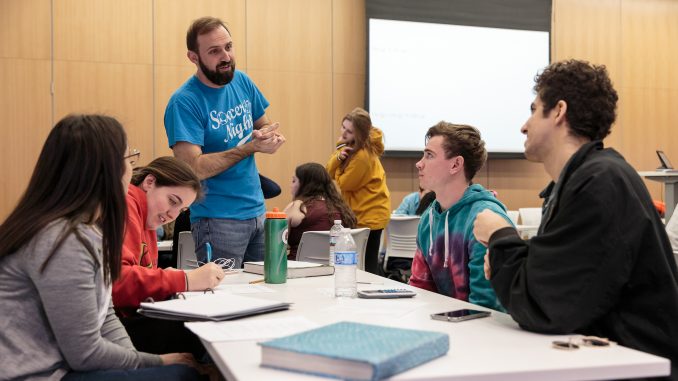
A complete redesign of 11 courses started with a simple question: how are students performing academically?
Stephanie Fiore hoped to find out. Fiore is the senior director of the Center for the Advancement of Teaching — which provides faculty members with programs and resources to help them improve their teaching methods. She asked Peter Jones, the senior vice provost for undergraduate studies, to analyze data about student performance. He noticed that the rates of failure and withdrawal were consistently high in certain subjects, like accounting, chemistry and kinesiology.
Fiore then developed The Student Oriented Active Redesign Project, which aims to lower the number of students who fail or withdraw from a course by incorporating an active learning approach, where students engage in the material through discussions and activities rather than just listening to lectures, she said.
To create active learning, SOAR often uses the “flip the classroom” model, in which students listen to a professor lecture in videos they watch before coming to class and then participate in more active discussions about the material during class time.
“It’s about what really great teaching methods can you employ in your classroom to help,” Fiore said. “That might be flipping, or that might be a version of active lecture, or it might be team-based learning. There are so many models for teaching that are good. It just depends on which ones fit your discipline and the content you’re teaching best.”
“We’re looking at it now from a teaching perspective and saying, ‘Is there a different way in which we can present the course that would engage the students more and improve the level of learning?’” Jones said.
Eleven courses were selected to use SOAR methods during Fall 2016 and Spring 2017. At least 21 percent of the students in these courses before Fall 2016 received a D or an F or withdrew from the course completely.
The faculty members who taught these classes, like accounting professor Elizabeth Gordon, attended training sessions over the summer.
Gordon, who has been teaching for nearly 20 years, said the summer training sessions made her feel more confident to try new teaching methods in her own classroom.
“Part of these big changes in higher education is that you have to be on the edge of what’s happening,” Gordon said. “You have to be current not only in your content, but in how you take that into the classroom.”
Kevin Delaney, the vice provost of faculty affairs who oversees programs created by the Center for the Advancement of Teaching, said SOAR can help students graduate more quickly and avoid retaking and paying for the same course.
“I think it puts the focus on where it ought to be: the teaching style, the learning style and what works best,” Delaney added.
Delaney said the early results are positive, and he has seen higher grades and fewer withdrawals from the 11 courses that underwent changes.
Gordon said she has seen more A’s and B’s in her accounting classes this year compared to other semesters, in addition to a 10 percent decrease in the rate of D’s, F’s and withdrawals in the course.
“We’re hoping that this program is a bit like … throwing a pebble into a pond and watching those ripples expand,” Jones said. “We’re hoping it’ll have an effect with teaching generally within the university, not just the ones that we’re directly working with.”
Moriah Thoman can be reached at moriah.thoman@temple.edu.


Be the first to comment